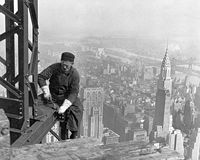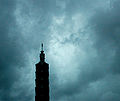
Skyscraper design and construction
Encyclopedia

Economics
Economics is the social science that analyzes the production, distribution, and consumption of goods and services. The term economics comes from the Ancient Greek from + , hence "rules of the house"...
, engineering
Civil engineering
Civil engineering is a professional engineering discipline that deals with the design, construction, and maintenance of the physical and naturally built environment, including works like roads, bridges, canals, dams, and buildings...
, and construction
Construction
In the fields of architecture and civil engineering, construction is a process that consists of the building or assembling of infrastructure. Far from being a single activity, large scale construction is a feat of human multitasking...
management.
Basic design considerations
Good structural design is important in most building design, but particularly for skyscrapers since even a small chance of catastrophic failure is unacceptable given the high price. This presents a paradox to civil engineers: the only way to assure a lack of failure is to test for all modes of failure, in both the laboratory and the real world. But the only way to know of all modes of failure is to learn from previous failures. Thus, no engineer can be absolutely sure that a given structure will resist all loadings that could cause failure, but can only have large enough margins of safety such that a failure is acceptably unlikely. When buildings do fail, engineers question whether the failure was due to some lack of foresight or due to some unknowable factor.Loading and vibration

Empire State Building
The Empire State Building is a 102-story landmark skyscraper and American cultural icon in New York City at the intersection of Fifth Avenue and West 34th Street. It has a roof height of 1,250 feet , and with its antenna spire included, it stands a total of 1,454 ft high. Its name is derived...
setbacks
Setback (architecture)
A setback, sometimes called step-back, is a step-like recession in a wall. Setbacks were initially used for structural reasons, but now are often mandated by land use codes.-History:...
are actually a result of the building code at the time, and were not structurally required. On the other hand John Hancock Center's
John Hancock Center
John Hancock Center at 875 North Michigan Avenue in the Streeterville area of Chicago, Illinois, is a 100-story, 1,127-foot tall skyscraper, constructed under the supervision of Skidmore, Owings and Merrill, with chief designer Bruce Graham and structural engineer Fazlur Khan...
shape is uniquely the result of how it supports loads. Vertical supports can come in several types, among which the most common for skyscrapers can be categorized as steel frames, concrete cores, tube within tube design, and shear walls.
The wind loading on a skyscraper is also considerable. In fact, the lateral wind load imposed on super-tall structures is generally the governing factor in the structural design. Wind pressure increases with height, so for very tall buildings, the loads associated with wind are larger than dead or live loads.
Other vertical and horizontal loading factors come from varied, unpredictable sources, such as earthquakes.
Shear walls
A shear wall, in its simplest definition, is a wall where the entire material of the wall is employed in the resistance of both horizontal and vertical loads. A typical example is a brickBrick
A brick is a block of ceramic material used in masonry construction, usually laid using various kinds of mortar. It has been regarded as one of the longest lasting and strongest building materials used throughout history.-History:...
or cinderblock wall. Since the wall material is used to hold the weight, as the wall expands in size, it must hold considerably more weight. Due to the features of a shear wall, it is acceptable for small constructions, such as suburban housing or an urban brownstone, to require low material costs and little maintenance. In this way, shear walls, typically in the form of plywood
Plywood
Plywood is a type of manufactured timber made from thin sheets of wood veneer. It is one of the most widely used wood products. It is flexible, inexpensive, workable, re-usable, and can usually be locally manufactured...
and framing, brick, or cinderblock, are used for these structures. For skyscrapers, though, as the size of the structure increases, so does the size of the supporting wall. Large structures such as castle
Castle
A castle is a type of fortified structure built in Europe and the Middle East during the Middle Ages by European nobility. Scholars debate the scope of the word castle, but usually consider it to be the private fortified residence of a lord or noble...
s and cathedral
Cathedral
A cathedral is a Christian church that contains the seat of a bishop...
s inherently addressed these issues due to a large wall being advantageous (castles), or ingeniously designed around (cathedrals). Since skyscrapers seek to maximize the floor-space by consolidating structural support, shear walls tend to be used only in conjunction with other support systems.
Steel frame
The classic concept of a skyscraper is a large steel box with many small boxes inside it. The genius of the steelSteel
Steel is an alloy that consists mostly of iron and has a carbon content between 0.2% and 2.1% by weight, depending on the grade. Carbon is the most common alloying material for iron, but various other alloying elements are used, such as manganese, chromium, vanadium, and tungsten...
frame is its simplicity. By eliminating the inefficient part of a shear wall, the central portion, and consolidating support members in a much stronger material, steel, a skyscraper could be built with both horizontal and vertical supports throughout. This method, though simple, has drawbacks. Chief among these is that as more material must be supported (as height increases), the distance between supporting members must decrease, which actually in turn, increases the amount of material that must be supported.
Tube frame

Fazlur Khan
Fazlur Rahman Khan was a Bangladeshi born architect and structural engineer. He is a central figure behind the "Second Chicago School" of architecture, and is regarded as the "Father of tubular design for high-rises"...
and J. Rankine defined the framed tube structure as "a three dimensional space structure composed of three, four, or possibly more frames, braced frames, or shear walls, joined at or near their edges to form a vertical tube-like structural system capable of resisting lateral forces in any direction by cantilevering from the foundation." Closely spaced interconnected exterior columns form the tube. Horizontal loads (primarily wind) are supported by the structure as a whole. About half the exterior surface is available for windows. Framed tubes allow fewer interior columns, and so create more usable floor space. Where larger openings like garage doors are required, the tube frame must be interrupted, with transfer girders used to maintain structural integrity. Tube-frame construction was first used in the DeWitt-Chestnut Apartment Building, designed by Khan and completed in Chicago
Chicago
Chicago is the largest city in the US state of Illinois. With nearly 2.7 million residents, it is the most populous city in the Midwestern United States and the third most populous in the US, after New York City and Los Angeles...
in 1963. It was used soon after for the John Hancock Center
John Hancock Center
John Hancock Center at 875 North Michigan Avenue in the Streeterville area of Chicago, Illinois, is a 100-story, 1,127-foot tall skyscraper, constructed under the supervision of Skidmore, Owings and Merrill, with chief designer Bruce Graham and structural engineer Fazlur Khan...
and in the construction of the World Trade Center
Construction of the World Trade Center
The construction of the World Trade Center was conceived as an urban renewal project, spearheaded by David Rockefeller, to help revitalize Lower Manhattan. The project was developed by the Port Authority of New York and New Jersey, which hired architect Minoru Yamasaki who came up with the specific...
.
A variation on the tube frame is the bundled tube, which uses several interconnected tube frames. The Willis Tower in Chicago used this design, employing nine tubes of varying height to achieve its distinct appearance. The bundle tube design was not only highly efficient in economic terms, but it was also "innovative in its potential for versatile formulation of architectural space. Efficient towers no longer had to be box-like; the tube-units could take on various shapes and could be bundled together in different sorts of groupings." The bundled tube structure meant that "buildings no longer need be boxlike in appearance: they could become sculpture."
Tube structures have since been used in many other later skyscrapers, including the construction of the World Trade Center
Construction of the World Trade Center
The construction of the World Trade Center was conceived as an urban renewal project, spearheaded by David Rockefeller, to help revitalize Lower Manhattan. The project was developed by the Port Authority of New York and New Jersey, which hired architect Minoru Yamasaki who came up with the specific...
, Petronas Towers, Jin Mao Building
Jin Mao Building
The Jin Mao Tower is an 88-story landmark supertall skyscraper in the Lujiazui area of the Pudong district of Shanghai, People's Republic of China. It contains offices and the Shanghai Grand Hyatt hotel. Until 2007 it was the tallest building in the PRC, the fifth tallest in the world by roof...
, and most other supertall skyscrapers since the 1960s. The strong influence of tube structure design is also evident in the construction of the current tallest skyscraper, the Burj Khalifa.
The elevator conundrum

Elevator
An elevator is a type of vertical transport equipment that efficiently moves people or goods between floors of a building, vessel or other structures...
was a precondition for the invention of skyscrapers, given that most people would not (or could not) climb more than a few flights of stairs at a time. The elevators in a skyscraper are not simply a necessary utility, like running water and electricity, but are in fact closely related to the design of the whole structure: a taller building requires more elevators to service the additional floors, but the elevator shafts consume valuable floor space. If the service core, which contains the elevator shafts, becomes too big, it can reduce the profitability of the building. Architects must therefore balance the value gained by adding height against the value lost to the expanding service core. Many tall buildings use elevators in a non-standard configuration to reduce their footprint. Buildings such as the former World Trade Center Towers use Sky Lobbies, where express elevators take passengers to upper floors which serve as the base for local elevators. This allows architects and engineers to place elevator shafts on top of each other, saving space. Sky lobbies and express elevators take up a significant amount of space, however, and add to the amount of time spent commuting between floors. Other buildings, such as the Petronas Towers, use double-deck elevator
Double-deck elevator
Double-deck elevators are designed with two elevator cars that are attached, one on top of the other. This allows passengers on two consecutive floors to be able to use the elevator simultaneously, significantly increasing the passenger capacity of an elevator shaft...
s, allowing more people to fit in a single elevator, and reaching two floors at every stop. It is possible to use even more than two levels on an elevator, although this has never been done. The main problem with double-deck elevators is that they cause everyone in the elevator to stop when only people on one level need to get off at a given floor.
See also
- List of architects of supertall buildings
- World's littlest skyscraperWorld's littlest skyscraperThe Newby-McMahon Building, commonly referred to as the world’s littlest skyscraper, is located at 701 LaSalle Street in downtown Wichita Falls, Texas. This late Neoclassical style red brick and cast stone structure is tall, and its exterior dimensions are deep and wide...
- List of cities with most skyscrapers

